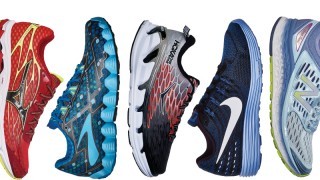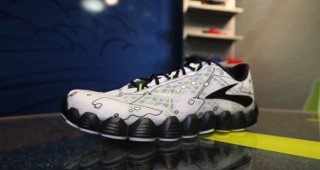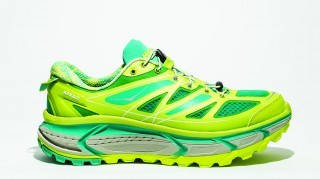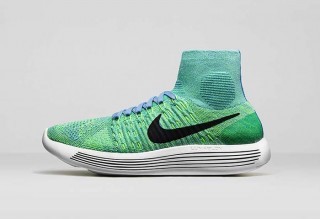Ryan Hall's Blog, page 281
March 7, 2016
2016 Running Gear Guide: Road Shoes

$170, Hokaoneone.com
Impossibly light for a shoe with
as thick of a midsole as it has, the Vanquish 2 is remarkably flexible and offers a nice mix of soft landings and energetic toe-offs, especially at moderate to fast paces. Not only is it considerably lighter than the previous edition (almost 2 full ounces lighter per shoe), it also rides more smoothly and is more responsive than the original. It still features a cradle design in which the foot and interior structure of the shoe are encased on the sides and bottom by a durable two-layer foam shell. Given the thickly cushioned chassis, a sense of ground-contact propriocep- tion and agility are understandably less in this shoe, but that becomes irrelevant once you find your groove out on the run. our testers found it best for long runs, progression runs and tempo runs, although it is still more than adequate for slower recovery runs—even though it doesn’t feel quite as smooth or responsive. “This shoe was a blast,” said one wear-tester. “It is one of the most responsive shoes I’ve ever run in. It sets the standard for energy return in a running shoe.”
weights: 9.8 oz. (men’s), 8.3 oz. (women’s)
heel-toe offset: 5mm; 32mm (heel), 27mm (forefoot)
The post 2016 Running Gear Guide: Road Shoes appeared first on Competitor.com.
Boston-Bound: Get Specific With 6 Weeks To Go!

Start visualizing crossing the finish line on Boylston Street during your fast-finish long runs. Photo: PhotoRun.net
This is it. These next four weeks—the two presented in this article and the two coming in the next installment—are where you will get in a lot of race-specific work, and they won’t be easy. You will need to hunker down, reduce all other life stresses as much as possible and really commit to these next four weeks as you prepare for the Boston Marathon.
Week 7
Week 7 is always interesting for me as a coach. I’m looking to see how you come off of the fast finish long run in Week 6. Some runners feel recovered in a day or two but others need 3-5 days before they feel ready for another intense workout. As a result, Week 7 should differ based on how you feel. Shift workouts to later in the week if necessary. Remember, no runner gets injured from taking an extra day or two of recovery between hard workouts, but many do from pushing too hard, too soon. So, use common sense as you plan Week 7.
Workout No. 1 (recovered runners, early in week): Medium Long Run. Run 1:30-1:45 over a hilly route.
Workout No. 1 (unrecovered runners, early in week): Easy Run. Run 40-60 minutes over flat route
Workout No. 2 (later in the week): Tempo Intervals. Warm up with 10-20 minutes of easy jogging, then run 3-4 times 2-3 miles at tempo interval pace (see McMillan Calculator) with 3-4 minutes of jogging recovery between each repetition. Run these on routes with lots of downhills. Cool down with 10-20 minutes of easy jogging.
You could just do another tempo run this week but I’ve found that a variety in workouts within the stamina/lactate threshold zone actually results in a greater boost in threshold speed and more enjoyment for the runner. So, I suggest you run tempo intervals this week.
Tempo intervals are repeats run right at (or slightly faster than) the lactate threshold with a recovery jog between repetitions. Most marathoners like this type of workout because they can run at a fast but controlled pace, but coming off the fast finish long run, the recovery in between the repeats helps keep this workout from being too demanding.
One caveat is that for runners who are concerned about dialing in goal pace or are still really tired from the fast finish long run, I suggest you run these repeats at goal marathon pace instead of tempo interval pace.
Long Run: 2:30-3:00 for sub-3 hour marathoners (22-26 miles); 3:00-3:45 for 3+ hour marathoners (18-22 miles). Note: Run this over a hilly course and surge slightly on the downhills to practice your downhill running.
Week 8
Week 8 is always a critical one, and it’s a bit of a yin-yang week. I like for runners to reduce their volume by 20 percent or so (and even run one less day than normal) so we keep our rhythm of a “down” week every fourth week of training. But, Week 8 does have some really challenging workouts, so it’s a down week for volume but not for intensity.
Workout No. 1 (mid-week): Yasso 800s. 8-10 x 800 meters (or 0.5 miles). Your goal time for each 800 meters is the minutes and seconds that correspond to the hours and minutes of your goal marathon. For example, if your goal is to run 3:45:00 for the marathon, then you try to hit 3:45 (3 minutes 45 seconds) for your 800s. Importantly, you take an equal amount of recovery (in our example 3:45 recovery jog) between repetitions.
You now know the drill with this workout from the previous article. Get in there and focus on putting in a solid effort. Hit your times. Savor every second of the recovery jog and run strong across this challenging workout. “Last reps, best reps” is a good mantra.
Workout No. 2 (advanced runners): Hill Repeats (early in week). Warm up with 10-20 minutes of easy jogging then perform 6-8 hill repeats lasting around 60 seconds on a moderately sloped hill (6-8 percent grade). Jog back down the hill for recovery between repeats and cool down with 10-20 minutes of easy jogging.
Long Run: Fast Finish Long Run: 14-18 miles (intermediate runners) or 16-20 miles (advanced runners) with the middle 6-8 miles at your goal marathon race pace and the last 1-2 miles all out. Cool down with 5-10 minutes of easy jogging. Note: Remember to use this a dress rehearsal to dial in nutrition, equipment, etc.
Alternative: This week, four weeks from Boston, is also a great weekend to run a tune-up race instead of the fast finish long run. My runners choose a half marathon. You can choose to run it as a fast finish long run (starting slower and finishing fast), as a goal marathon pace run (running the entire race at goal marathon pace) or as an all-out race to get a gauge of marathon readiness. You can put your half-marathon finish time in the McMillan Calculator to get a prediction of your marathon time.
The post Boston-Bound: Get Specific With 6 Weeks To Go! appeared first on Competitor.com.
Shoe Talk: Brooks Neuro

Let’s take a closer look at the Brooks Neuro, an outside-the-box running shoe Brooks released in the spring of 2016.
RELATED: Shoe Talk: New Balance Fresh Foam 1080
The post Shoe Talk: Brooks Neuro appeared first on Competitor.com.
March 4, 2016
Love Your Maximalist Shoes? What You Need to Know

Jason Bahamundi will go to his grave clutching his pair of Hoka One One running shoes. The finisher of five Ironman races and multiple ultramarathons swears by the big, cushy shoes—and he’s not alone. The brand saw sales increase 350 percent from 2013 to 2015 and most running shoemakers now have a maximalist offering. As legions of runners flock to the over-cushioned category, however, they risk some tradeoffs if they don’t do some back-end work—a false sense of security being one.
“The shoes might not be bad, but they will allow you to get away with some movement dysfunction,” says elite runner, physician and natural running advocate Mark Cucuzzella. “If an 80-year old runner wants to run a few miles a week and these shoes allow him or her to do that, great. But for a young marathoner putting in high mileage, ultimately the body will pay a price if the runner doesn’t have good form.”
Physical therapist Dr. Robert Gillanders from Washington, D.C., agrees. “If you think all that cushion will fix things or allow you to stay injury-free, you are being short-sighted,” he says. “When we step back and look over injury statistics dating to the 1970s, not much has changed. Runners still make the same mistakes and equipment variations aren’t improving that.”
Gillanders points out that research shows runners who avoid injuries tend to be those who land softly. He worries that when a runner straps on a heavily cushioned shoe, he or she perceives a soft landing when in fact the opposite is true. He points to a 2007 study in the Journal of Sports Science that tested athletes landing on force plates. When told they were running on soft surfaces, they actually hit the ground harder than when they perceived themselves to be running across hard surfaces.
RELATED: How Runners Can Improve Foot Strength
Houston-based runner James Dykas recently made the switch from a minimal shoe to the Altra Torin, the company’s second most cushioned model, on a physician’s recommendation. He feels the difference in a lack of control. “I am more apt to attack the ground in less shoe whereas in the bigger shoe, I gingerly make my way through an area of concern, like a broken stretch of sidewalk,” he says. “The more cushion I am wearing, the less I feel like I am running, and the more I feel like I am just moving forward.”
Cucuzzella maintains that running in a big shoe prevents the foot from functioning as it is designed—as a spring rather than a shock absorber. “Our feet are the first thing to hit the ground,” he says. “They control the forces that hit our body and when you are wearing lots of cushion, they can’t activate and perform that function.”
RELATED: 12 Things To Know About Maximalist Shoes
Closing The Gaps
So what’s a runner like Bahamundi to do? Ensure that his feet are strong and his body is primed for proper mechanical function, says Gillanders. “In my clinic, I don’t spend time focusing on footwear,” he explains. “I am looking for things like mobility, balance and stability throughout the kinetic chain.”
The PT commonly works with runners on their posterior chain strength and neutral positioning. “Runners need to demonstrate static stability before they can lead into moving stability,” he says. “There’s no substitute for the basics.”
Bahamundi has been very conscientious about this. “As soon as I come in from a run, the shoes are off and I am walking around in my bare feet,” he says. “I also do balance work that intertwines with my core work and strength work.”
His regimen includes things like rolling a ball under his feet, picking up items with his toes and standing balance work. “This has helped me strengthen my body and allow [my shoes] to be an asset rather than a liability,” Bahamundi says.
Cucuzzella says that these are all part and parcel to making a heavily cushioned shoe work for a runner. “If you counter the time spent in these shoes with lots of time in your bare feet or minimalist shoes at other times, you’ll improve your odds of avoiding injury,” he explains. “The body needs variability.”
Gillanders likes to see runners strengthen the muscles going into the foot, as well as working to make the foot stable. “In maximalist models, in particular, there’s a good deal of play that can impact the posterior tibialis,” he says. “Whatever the shoe, a runner should be on a path to kinetic chain stability.”
While Dykas isn’t yet convinced the cushioned shoes will work for him, Bahamundi will never look back. “At the end of the day, it’s performance that matters to me,” he says. “I was able to run two 100-milers in a two-week period and I’m convinced I wouldn’t have been able to do that if it weren’t for the shoes.”
RELATED: Will The Maximalist Shoe Trend Endure?
The post Love Your Maximalist Shoes? What You Need to Know appeared first on Competitor.com.
March 3, 2016
7 Injuries That Could Be Causing Your Hip Pain

Photo: Shutterstock.com
Of the joints in the leg that are commonly injured in runners, the hip often poses the most difficult diagnosis. There are a couple of reasons for this: First, there are simply too many possible causes, and a second, less obvious reason, relates to the frequency of these injuries.
The bony anatomy of the hip is actually quite straightforward. The head of the femur ends in a ball that articulates with a pocket in the pelvic bone, the acetabulum. This forms the classic ball-in-socket joint. Yet, because of the extreme forces that this joint is subjected to, especially when running, and because of the very complicated supporting structures that help make it among one of the strongest and most stable joints in the body, many potential injuries are possible. Because the hip plays such an important role in weight bearing and locomotion, it is of the utmost importance to identify these injuries as early as possible, and treat them before they result in joint damage.
We’ll review the more commonly encountered causes of hip pain in runners: muscular strains and pulls in the groin, hamstring or piriformis, hip flexor tightness, bursitis, stress fractures and labral tears. Iliotibial band friction syndrome (ITBFS) may also cause hip pain, but has been widely covered, and therefore will not be discussed in this article.
RELATED: A DIY Guide to Managing IT Band Syndrome
Groin Pulls or Tears
A pulled groin is caused by a strain in the hip adductors, muscles that pull the legs together. These muscles attach to the thighbones at the level of the hip and run down the inside of the thigh, stabilizing the joint. When overstretched or overused, small tears can develop resulting in pain, swelling, and a dull ache in the groin area. Severe tears occur more suddenly and are associated with very sharp pain and bruising down the leg.
Unfortunately, many hip injuries can cause groin pain as well, so distinguishing a true groin pull from other possibilities may not always be that straightforward. Usually a focused history and physical exam suffice to confirm the diagnosis.
The treatment of a groin pull is similar for other pulled muscles. Rest, ice, compression and elevation can all help to alleviate symptoms. Anti-inflammatory medications or acetaminophen can be used to treat pain and once the injury has healed sufficiently, a gradual return to activity can then follow.
RELATED: Hip Adductors: The Root of Your Injuries?
Hamstring Injuries
The hamstrings are made up of three distinct muscles that run down the back of the thigh, which then operate together as powerful knee flexors. Like all muscular injuries, hamstring injuries occur when fibers within the muscles tear. The severity of the injury is determined by the amount of damage and how completely the fibers are torn—the least severe form being a strain, while the most severe consists of a complete tear.
Hamstring injuries are almost always associated with pain in the back of the leg that gets worse with flexing the knee. However, if the injury is higher up in the muscle body, then the symptoms can be experienced in the hip itself.
Piriformis Syndrome
The piriformis is a small muscle that runs from the sacrum to the outside of the hip. For a small muscle it can cause big problems when inflamed or overused. Because it runs over the sciatic nerve, the piriformis has a nasty habit of putting pressure on this nerve and causing exquisite pain in the glute and posterior hip area when it swells or spasms.
Aside from addressing any mechanical issues that might be exacerbating the problem the main way to treat piriformis syndrome is by stretching the muscle out as much as possible. To stretch the piriformis: lay on your back, bend your knees and cross your right leg over your left so your right ankle rests on your left knee in a figure four position. Bring your left leg toward your chest by bending at the hip. Reach through and grab your left thigh to help pull everything toward your chest.
VIDEO: Injury Prevention 101: The Piriformis and the Glute
Iliopsoas Syndrome
The iliopsoas muscle is a powerful hip flexor that runs across the top of the hip joint and works to pull the knee up and off the ground when it contracts. Movement of the tendon is facilitated by the iliopsoas bursa. If the tendon or the bursa becomes inflamed, flexion may become very painful and the pain is felt in front of the hip with an associated snapping or clicking sensation during movement. Iliopsoas syndrome often arises as a result of increasing volume or intensity too quickly, and hence this problem may be easily avoided. Once it has set in though, the only effective treatment is rest with liberal use of anti-inflammatory medications.
Hip Bursitis
Bursae are fluid-filled sacs that assist in lubricating the movement of structures around joints. The hip bursa allows for the smooth movements of various tendons over each other as the hip ranges in different directions. In some instances this sac can become inflamed after repetitive micro-trauma common in long-distance running. The inflammation can be very painful with symptoms predominantly over the outer aspect of the hip radiating down into the thigh.
Once inflamed, the treatment for hip bursitis is similar to many of the other injuries described here: rest, the application of ice and the use of anti-inflammatory medications. Although it is rare, in some cases the bursitis may become severe or chronic and require surgery.
Stress Fracture
Although much more common in the foot and lower leg, stress fractures of the hip may also occur. Stress fractures result from a combination of overuse in the setting of muscle fatigue, and in some cases, predisposed anatomical issues. Under normal circumstances the muscles and tendons absorb the vast majority of the forces transmitted during repeated ground striking in running. However, with progressive fatigue, more and more of the force is transmitted to the underlying bone, and with time the bone may fracture.
Unlike a traumatic injury, in which there is a sudden tremendous force applied that results in an obvious disruption of the bone, stress fractures are insidious and take time to manifest symptoms. Stress fractures of the hip will cause a dull ache either felt in the groin or lower back, and this can delay the diagnosis allowing more time for the fracture to worsen. Once suspected, confirming the diagnosis can also be difficult as the bone may appear normal on plain X-rays. Only more advanced imaging will show the problem definitively.
Once diagnosed, a complete cessation of weight bearing exercise is mandated. This is critical in order to prevent the stress fracture from progressing to a much more serious and complete fracture. The duration of recovery will depend on the severity of the injury and, in rare cases, surgical intervention may be required.
Labral Tear of the Hip
The labrum of the hip is a cartilage ring that forms a kind of lubricating O-ring around the ball of the femur holding it in place in the acetabulum. In some people, bony abnormalities either of the neck of the femur or of the lip of the acetabulum can cause the labrum to become repetitively impinged with normal ranging of the hip joint. Over time, this impingement causes the labrum to fray and eventually tear.
Until recently, the long-term importance of labral tears wasn’t completely appreciated. Now, these tears are seen as a potential contributor to the early development of arthritis of the hip.
Because the labrum is made of cartilage and therefore completely insensate, the symptoms of a labral tear arise only long after the damage has been done. Patients with this problem frequently complain of pain in the groin that gets worse when crossing the affected leg over the other. Hence, the diagnosis is difficult to confirm and requires an MRI with contrast injected into the joint. Once confirmed, the only treatment options for symptomatic patients are the complete cessation of weight bearing activities or surgery. It is important to note that not all patients with labral tears require surgical repair. This should be discussed with an orthopedic surgeon familiar with the diagnosis and the procedure to address it.
The hip joint is less prone to injury than the lower leg but can still be afflicted by a number of issues both big and small. Quickly arriving at the correct diagnosis is an important part of getting effective treatment and returning to activity. Knowing the common causes of hip and groin pain is also an important part of that equation. See your physician whenever you have vague, non-specific pains that are difficult to ascribe to a specific area. This can often end up being something more important than you might initially think and catching it early is key.
* * *
About the Author: Jeffrey Sankoff, MD is a three time Ironman and 70.3 World Championship qualifier. He is an Emergency Physician at Denver Health Medical Center in Denver.
The post 7 Injuries That Could Be Causing Your Hip Pain appeared first on Competitor.com.
From Start to Finish: The Beginner Runner’s Welcome Package

Photo: istockphoto.com
Lacing up your shoes as a new runner and training for your first race is an exciting, rewarding experience. You’ll have the chance to get in the best shape of your life, but more than that you’ll experience new things and expand your athletic horizons. You’re joining an inclusive and supportive community of motivated people on a journey of self-discovery. You’ll tackle new challenges and likely learn more about yourself in the next few months than you have in the past few years.
But you probably have some questions:
• How much should I run per week?
• How can I get faster?
• Should I run races for time or just to finish?
• How do I stay healthy and prevent injuries?
Starting a training program for the first time can be an overwhelming endeavor, but below we’ll provide the answers to these questions to ensure you enjoy your new sport, have a great race experience and a long, rewarding career as a runner.
How much should I run per week?
New runners are most limited by a lack of endurance, or an underdeveloped aerobic capacity. Therefore, increasing endurance should be your top goal. Developing your aerobic capacity will help you race faster by boosting stamina and improving your ability to hold a pace for a longer period of time.
By running more, your body will experience significant adaptations, including improved efficiency and running economy, increased mitochondria levels in the muscles and a higher aerobic capacity.
You may have heard of the 10 percent rule, which states that you can increase your weekly mileage by 10 percent each week. This is a good general guideline, but it has its limitations. More conservative increases in running volume can help new runners limit the risk of injury. This cautious approach will pay off long-term as consistency and injury prevention are prioritized over big jumps in mileage.
Most new runners typically run two to four days per week totaling 10 to 20 miles. These runners are best served adding one to two miles every other week, with an emphasis on increasing a once-a-week long run.
For example, if you’re running 11 miles per week in three runs (3, 3, and 5 miles), add one mile to your long run every other week. You can also add a mile to one of the midweek runs every other week. In a matter of weeks, your overall mileage will double and your risk of getting injured will be kept to a minimum. But what if you can’t run the entire distance? It’s OK—take walking breaks if necessary. The primary goal is to complete the distance; the secondary goal is to run the full distance.
RELATED: A Smarter Way to Increase Running Mileage
How can I get faster?
Most new runners—or novice runners who haven’t trained with a group or followed a plan—typically go out and run the same pace all the time. The way to improve your fitness and become a faster runner is to mix up the types of training runs you do each week.
Like any other aspect of training, it’s best to start gradually when mixing in elements of speed. Strides and hill sprints will help lay a foundation that prepares the body for longer, more challenging workouts in the future. Strides are roughly 100-meter accelerations that build to about 95 percent of maximum speed. Hill sprints are eight- to 10-second maximum-intensity sprints up a moderately steep hill. Both require full recoveries between repetitions.
New runners can implement strides or hill sprints into their training program after one to two weeks of consistent easy running. After three or four weeks of strides and hill sprints once or twice a week, you’ll be ready to attempt your first speed workout.
A fartlek session (Swedish for “speed play”) is a great introductory workout that mixes intervals of faster and slower running. For example, after 5 to 10 minutes of warm-up jogging, alternate running 1-minute faster segments at a comfortably hard pace and 2 minutes of easy running as recovery until you’ve done six of each, then cool down with 5 to 10 minutes of easy jogging. Fartlek workouts are versatile and can be run almost anywhere.
New runners who start with strides or hill sprints for a few weeks and gradually progress to fartlek workouts are taking a systematic, logical approach to introducing speed workouts into their training, which helps reduce the risk of injury while prioritizing consistent improvement.
RELATED: The Two Best Speed Workouts for New Runners
Should I run races for time or just to finish?
Setting a goal finishing time is often thought of as an advanced runner’s concept, but even new runners can aim to finish their first race under a certain time.
Since the first several months of your running career are focused on establishing consistency, gradually building mileage and increasing fitness, it’s best to set goal times for shorter races that you know you can finish. Once you know you can finish a race, the next step is to run it faster.
So if the race is less than 10K in distance, set a goal time based on marks you’ve set in training. For example, if 9 minutes per mile is a comfortable training pace for you, you may try to finish your first 10K at 8:45 per mile or your first 5K at 8:30 per mile.
Free Beginner 5K and 10K Training Plans
Longer races like the marathon or half marathon require more advanced training, maturity as an athlete and dealing with complex logistics. Until you have years of experience before your first long race, it’s best to set a goal of just finishing it. The personal bests will come later!
Free Beginner Half Marathon Training Plan
How do I stay healthy and prevent injuries?
Running can lead to a variety of overuse injuries and muscular strains, but training with a preventive mindset and additional strength workouts can help keep you healthy.
Preventing injuries should be a top priority for every new runner. “Sandwiching” each run between a dynamic warm-up and a core or strength workout can dramatically reduce your risk of injuries.
A dynamic warm-up includes exaggerated movements that mimic running, like leg swings, donkey kicks, lunges, hurdle drills and skips. Perform four to six exercises for 5 to 10 minutes in total before starting your run to increase your heart rate, improve circulation and prime the body to run.
A post-run strength workout can include squats, planks, bridges, lunges, push-ups, pull-ups and leg raises. These basic exercises train movements, not muscles, and are more running-specific than bodybuilding-oriented exercises such as bicep curls or bench presses. Improving mobility, along with strength, will help keep your risk of injury minimal.
RELATED: Strength-Training Circuit for Distance Runners
The post From Start to Finish: The Beginner Runner’s Welcome Package appeared first on Competitor.com.
Adidas Grand Prix Meet Moving From Icahn Stadium To The Streets

The new adidas street meet will continue to highlight the Dream 100 and Dream Mile races, which have become an end-of-season fixture for the top prep athletes in the country. Photo: PhotoRun.net
The adidas Grand Prix, one of the United States’ premiere professional track meets that’s taken place at New York City’s Icahn Stadium for more than a decade, is moving to the streets this summer.
Global Athletics & Marketing, Inc., the company which puts on the meet, along with title partner, adidas, will shift the focus of the June event—which had been on the Diamond League circuit since 2010—in an effort to expose track and field to a wider audience. The new event, which will take place on the Big Apple’s city streets, will feature elite distance and sprint races as well as popular field events such as the pole vault and long jump.
“Our 11 years of producing a high-caliber event at Icahn Stadium have advanced the sport of track and field in the U.S.,” Mark Wetmore, president of GA&M and director of the meet since its founding in 2005, said in a release. “We are proud of what we’ve accomplished and honored by the devotion of our many fans over the years. It’s been a pleasure to give them the chance to see their favorite athletes and, often, their national heroes in person. It’s been a great run on Randall’s Island, and now we’re looking ahead to producing a new event that will bring the sport to a whole new audience.”
Exact dates, race lineups and athletes for the new event are expected to be announced in early April.
The post Adidas Grand Prix Meet Moving From Icahn Stadium To The Streets appeared first on Competitor.com.
Nike Debuts Over-The-Ankle LunarEpic Flyknit Running Shoes

TheLunarEpic Flyknit features an unique over-the-ankle knit upper and an innovative Lunar foam midsole/outsole unit.
Nike has staked its claim with innovative running shoes since its inception nearly 45 years ago. The brand’s Air Tailwind (which featured the original Nike Air cushioning system), Sock Racer, Air Hurache, Free and Flyknit Racer are just a few of the shoes that serve as examples of its leading-edge design ethos and innovative functionality. Here’s a close-up look at the brand-new LunarEpic Flyknit ($175), which launches on March 3 at various retail shoes and at Nike.com. Scroll through the photos below to see the unique design details and technological innovations from this shoe that fits like a sock. (This is a brief preview of the LunarEpic Flyknit, not a subjective review. Competitor will be testing this shoe later today.)
Photo Gallery
1 of {count}
Back to Start
View Larger Image

Nike LunarEpic Flynkit
Nike says the conception of the LunarEpic Flyknit began over 18 months ago. Taking insights from Nike’s Magista soccer shoes, which allows the foot, ankle and lower leg to work together as a single unit to emphasize natural movement and a feeling of fluidity, the company’s designers set out to create a running shoe that imparted the same sensation, while still serving runner’s key needs: fit, feel and force. TheLunarEpic Flyknit features a unique over-the-ankle knit upper and an innovative Lunar foam midsole/outsole unit.
View Larger Image

Nike LunarEpic Flynkit
Nike says its designers constructed a lightweight, breathable one-piece Flyknit upper, engineering different densities directly into the knit for precise support: a snug fit at the arch, heel and forefoot. Meanwhile, the mid-height collar was added to facilitate a locked-down fit, both from a physical point of view and a proprioceptive perspective. Nike Flywire cables were knitted into the upper for additional strength and a close, dynamic fit.
View Larger Image

Nike LunarEpic Flynkit
Using heat (instead of glue), designers fused two foams into one piece that still features traditional Lunarlon construction, with a slightly firmer foam carrier and a softer foam core. Laser siping on the side of the midsole facilitates cushioning and targeted flexibility.
View Larger Image

Nike LunarEpic Flynkit
Last but not least, is a rubber-free outsole with laser-siped geometric cushioning "pistons" (inspired by pressure maps of the foot). Constructed of Lunarlon foam, each piston moves individually, enabling pointed compression that Nike says results in an optimally cushioned ride. Maximizing both cushioning and traction, it has been engineered to provide unrivaled heel-to-toe transitions and propelling energy return.

More Galleries
The post Nike Debuts Over-The-Ankle LunarEpic Flyknit Running Shoes appeared first on Competitor.com.
March 2, 2016
Workout Of The Week: In/Out Miles

Sergio Reyes. Photo: www.photorun.net
The Coach: Joe Rubio of the Asics Aggies Training Group, San Luis Obispo, Calif.
The Athlete: Sergio Reyes, 2010 U.S. marathon champion
When They Did It: Training for the 2012 edition of the Rock ’n’ Roll San Jose Half Marathon, where Reyes finished second overall in a new PR of 1:03:30.
Why They Did It: According to Rubio, this workout “teaches athletes to better utilize lactate as a fuel by forcing the recoveries to be maintained at a solid effort between the more traditional harder mile repeats.” In other words, this is a continuous workout and better simulates a race, which affords runners no time to jog or recover.
“The volume of the workout lends itself to be most beneficial to 10K, half-marathon and marathon runners,” Rubio says.
RELATED: Workout Of The Week: Race Week Workouts
How They Did It: The In/Out Miles workout should be run on the track. The session consists of alternating 1,600 meters or 1 mile (four laps) run at goal 10K pace with 1600m or 1-mile run 60 seconds slower. During his training for the half-marathon, Reyes typically ran four “fast miles” out of 7-12 miles total. For a 40-minute 10K athlete, an appropriate workout would be running a mile at 6:27 followed by a mile at 7:27, back and forth in this fashion for 7-12 miles total, not counting the warmup or cool down.
How You Can Apply The Workout: The key to this workout is to know how fast you should be running your “In” and “Out” miles. If you are at the beginning of your training cycle, err on the side of conservative. Beginners should start out with a four-mile session that includes two “In” miles and two “Out” miles. Gradually increase the total amount of faster miles and duration of the workout from week to week, working up to an eight-mile session that includes four fast miles two weeks before your goal race.
The post Workout Of The Week: In/Out Miles appeared first on Competitor.com.
Trail of the Week: Cactus to Clouds, Palm Springs, California

Photo: Jeremy Francis
Our Trail of the Week feature is made possible through a partnership with Trail Run Project, a crowd-sourced collaboration by and for the running community. Thanks to Jeremy Francis for mapping and describing this route.
Ready for an epic challenge?
This section of the Cactus to Clouds trail covers the distance between the Palm Springs Art Museum and the Aerial Tramway station along the ridge. It starts on the desert floor in Palm Springs, Calif. and climbs 10,000 feet in just 14 miles, finishing high up on Mt. San Jacinto. The Palm Springs Aerial Tram can take you back down.
A few tips:
There is no reliable water along the trail.
There can be extreme weather changes between the desert floor and the subalpine mountain ridge line. The lower trail has recorded temperatures as high as 110 F while the summit can drop to -10 F in winter. It is recommended you start early in the morning, well before sunrise. 3-5 a.m. is a typical start time.
This route requires commitment. Once past the halfway point, it is more difficult to turn around than to push forward.
This trail is extremely exposed and dangerously hot in the summer.
The Data
Miles: 14.4
Runnable: 67 percent
Average Grade: 14 percent
Max Grade: 109 percent
Total Ascent: 10,444 feet
Total Descent: -172 feet
Highest Elevation: 10,751 feet
For a closer look, check out the interactive map, data, photos and virtual run simulator courtesy of Trail Run Project:
The post Trail of the Week: Cactus to Clouds, Palm Springs, California appeared first on Competitor.com.
Ryan Hall's Blog
- Ryan Hall's profile
- 21 followers



